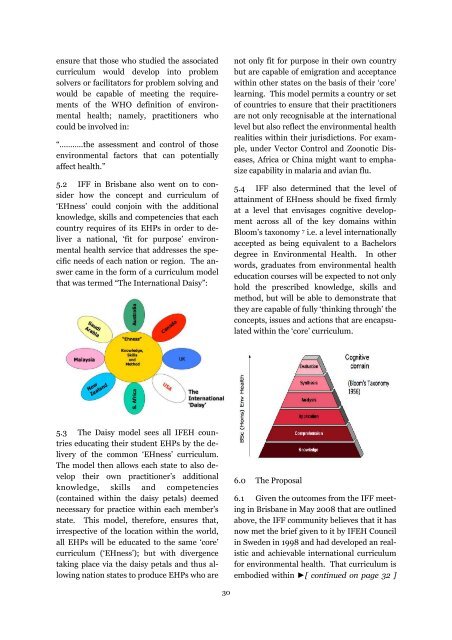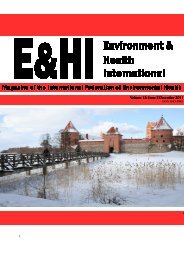ISSN 1683-3805
E&HI Volume 11, No. 1 2009 - International Federation of ...
E&HI Volume 11, No. 1 2009 - International Federation of ...
- No tags were found...
Create successful ePaper yourself
Turn your PDF publications into a flip-book with our unique Google optimized e-Paper software.
ensure that those who studied the associated<br />
curriculum would develop into problem<br />
solvers or facilitators for problem solving and<br />
would be capable of meeting the requirements<br />
of the WHO definition of environmental<br />
health; namely, practitioners who<br />
could be involved in:<br />
“………..the assessment and control of those<br />
environmental factors that can potentially<br />
affect health.”<br />
5.2 IFF in Brisbane also went on to consider<br />
how the concept and curriculum of<br />
‘EHness’ could conjoin with the additional<br />
knowledge, skills and competencies that each<br />
country requires of its EHPs in order to deliver<br />
a national, ‘fit for purpose’ environmental<br />
health service that addresses the specific<br />
needs of each nation or region. The answer<br />
came in the form of a curriculum model<br />
that was termed “The International Daisy”:<br />
not only fit for purpose in their own country<br />
but are capable of emigration and acceptance<br />
within other states on the basis of their ‘core’<br />
learning. This model permits a country or set<br />
of countries to ensure that their practitioners<br />
are not only recognisable at the international<br />
level but also reflect the environmental health<br />
realities within their jurisdictions. For example,<br />
under Vector Control and Zoonotic Diseases,<br />
Africa or China might want to emphasize<br />
capability in malaria and avian flu.<br />
5.4 IFF also determined that the level of<br />
attainment of EHness should be fixed firmly<br />
at a level that envisages cognitive development<br />
across all of the key domains within<br />
Bloom’s taxonomy 7 i.e. a level internationally<br />
accepted as being equivalent to a Bachelors<br />
degree in Environmental Health. In other<br />
words, graduates from environmental health<br />
education courses will be expected to not only<br />
hold the prescribed knowledge, skills and<br />
method, but will be able to demonstrate that<br />
they are capable of fully ‘thinking through’ the<br />
concepts, issues and actions that are encapsulated<br />
within the ‘core’ curriculum.<br />
5.3 The Daisy model sees all IFEH countries<br />
educating their student EHPs by the delivery<br />
of the common ‘EHness’ curriculum.<br />
The model then allows each state to also develop<br />
their own practitioner’s additional<br />
knowledge, skills and competencies<br />
(contained within the daisy petals) deemed<br />
necessary for practice within each member’s<br />
state. This model, therefore, ensures that,<br />
irrespective of the location within the world,<br />
all EHPs will be educated to the same ‘core’<br />
curriculum (‘EHness’); but with divergence<br />
taking place via the daisy petals and thus allowing<br />
nation states to produce EHPs who are<br />
6.0 The Proposal<br />
6.1 Given the outcomes from the IFF meeting<br />
in Brisbane in May 2008 that are outlined<br />
above, the IFF community believes that it has<br />
now met the brief given to it by IFEH Council<br />
in Sweden in 1998 and had developed an realistic<br />
and achievable international curriculum<br />
for environmental health. That curriculum is<br />
embodied within ►[ continued on page 32 ]<br />
30



